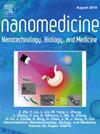含辣椒素纳米纤维抑制人慢性白血病K562细胞生长的体外研究
IF 4.6
2区 医学
Q2 MEDICINE, RESEARCH & EXPERIMENTAL
Nanomedicine : nanotechnology, biology, and medicine
Pub Date : 2025-10-03
DOI:10.1016/j.nano.2025.102864
引用次数: 0
摘要
以壳聚糖和聚乙乙醇纳米纤维为底物,研究不同浓度(2 %、6 %和10 %)的红辣椒活性物质辣椒素对K562白血病细胞的抗癌作用。为此,以壳聚糖(Cs)和聚乙烯醇(PVA)聚合物为原料,以辣椒素为抗癌药物,采用静电纺丝法制备了20/80比例的纳米纤维。利用场发射扫描电镜对制备的纳米纤维的性能进行了评价。此外,还利用金纳米颗粒对K562癌细胞的杀伤效果进行了分析和比较。该细胞系由巴斯德细胞库制备,在DMEM培养基中培养。随后,通过存活实验、膜联蛋白和碘化丙啶染色细胞凋亡实验和细胞划痕实验来评估不同浓度合成纳米纤维的抗癌作用。电镜研究表明,纳米纤维结构均匀,纯度高。结果表明,辣椒素在72 h (P本文章由计算机程序翻译,如有差异,请以英文原文为准。

Inhibition of growth of the human chronic leukemia cancer cell line K562 using capsaicin-containing nanofibers: an in vitro study
This study aims to investigate the anticancer properties of capsaicin, the active substance of red pepper, in different concentrations (2 %, 6 %, and 10 %) by chitosan and polyvinyl alcohol nanofiber substrate, against the K562 leukemia cell line. For this purpose, chitosan (Cs) and polyvinyl alcohol (PVA) polymers were used to produce nanofibers with a 20/80 ratio by electrospinning, with capsaicin serving as the anticancer drug. The properties of the fabricated nanofibers were evaluated by field emission scanning electron microscopy. Also, gold nanoparticles were used to analyze and compare its effectiveness against the K562 cancer cell line. This cell line was prepared from Pasteur cell bank and cultured in DMEM medium. Subsequently, the anticancer effect of synthetic nanofibers in different concentrations was assessed by performing survival test, apoptosis by annexin and propidium iodide staining, and cell scratch assay. The electron microscopy study demonstrated the uniformity and purity of the nanofiber structure. The results showed that capsaicin, dose-dependently, reduced the viability of K562 cells after 72 h (P < 0.01). The apoptotic assay also indicated that the induction of apoptosis significantly increased by PVA/Cs/Caps(2 %) and PVA/Cs/Au(5 %)/Caps(10 %) compounds in the studied cell line (P < 0.0001). Furthermore, scratch assay at 24, 48, and 72 h demonstrated that the mentioned compounds possess anti-migration potential, particularly at 48 h. Our results suggest that capsaicin in nanofiber substrate can show anticancer properties against the K562 leukemia cell line. Therefore, this compound can be considered a potential candidate for the treatment of leukemia.
求助全文
通过发布文献求助,成功后即可免费获取论文全文。
去求助
来源期刊
CiteScore
11.10
自引率
0.00%
发文量
133
审稿时长
42 days
期刊介绍:
The mission of Nanomedicine: Nanotechnology, Biology, and Medicine (Nanomedicine: NBM) is to promote the emerging interdisciplinary field of nanomedicine.
Nanomedicine: NBM is an international, peer-reviewed journal presenting novel, significant, and interdisciplinary theoretical and experimental results related to nanoscience and nanotechnology in the life and health sciences. Content includes basic, translational, and clinical research addressing diagnosis, treatment, monitoring, prediction, and prevention of diseases.

 求助内容:
求助内容: 应助结果提醒方式:
应助结果提醒方式:


